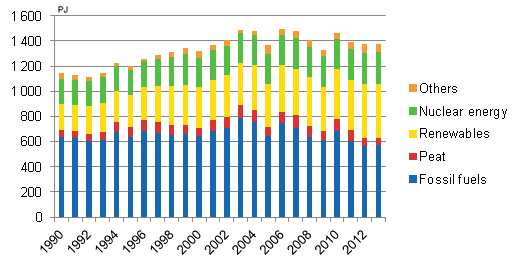Published: 10 December 2014
Total energy consumption remained on level with the previous year in 2013
According to Statistics Finland, total consumption of energy in Finland amounted to 1.37 million terajoules (TJ) in 2013, which was on level with the previous year. The consumption of electricity totalled 84 TWh, which was one per cent less than in the previous year. The use of renewable energy sources decreased by one per cent and that of fossil fuels increased by two per cent. Wood fuels were still the largest source of energy.
Total energy consumption 1990–2013

The share of renewable energy of total energy consumption decreased in 2013 and stood at 31 per cent. The biggest decline was seen in the use of hydro power. The use of forest chippings rose to a new record level in 2013, and five per cent more was used than in 2012. EU targets for renewable energy are calculated relative to total final energy consumption; calculated in this manner, the share of renewable energy was 35 per cent in Finland in 2013 based on preliminary data. Finland's target for the share of renewable energy is 38 per cent of final energy consumption in 2020.
Total energy consumption 2012–2013, terajoule
| 2013 | 2012 | Change % | |
| Wood fuels | 338 669 | 331 511 | 2 |
| Oil | 316 598 | 327 091 | -3 |
| Nuclear energy | 247 347 | 240 685 | 3 |
| Coal | 151 135 | 122 651 | 23 |
| Natural gas | 106 943 | 115 002 | -7 |
| Peat | 56 900 | 65 000 | -12 |
| Net imports of electricity | 56 574 | 62 796 | -10 |
| Hydro power | 45 621 | 60 001 | -24 |
| Wind power | 2 785 | 1 780 | 57 |
| Others | 50 591 | 45 153 | 12 |
| Total | 1 373 164 | 1 371 670 | 0 |
The use of fossil fuels went up by two per cent from the year before. Of fossil fuels, the use of natural gas fell by seven per cent and the use of peat by 12 per cent from 2012. The consumption of coal (including hard coal, coke, and blast furnace and coke oven gas) increased by 23 per cent. Long-term consumption development cannot be deducted from the change in hard coal consumption in successive years. According to Statistics Finland’s preliminary data, the consumption of hard coal turned to decline in 2014.
The availability of hydro power declined in the Nordic countries in 2013. The production of hydro power decreased by 24 per cent in Finland. The production of wind power increased by 57 per cent, and it accounted for 0.9 per cent of all electricity produced. Production of nuclear power grew by three per cent from the previous year. Altogether, 27 per cent of electricity consumption was covered with nuclear power.
Imports of electricity decreased by eight per cent. The largest amount of electricity was imported from Sweden, from where imports amounted to 12.4 TWh. Finland was a net buyer on the Nordic electricity market. Imports from Russia increased by seven per cent from 2012. In all, 14 per cent more electricity was exported than one year before. Net imports of electricity covered 19 per cent of total electricity consumption.
Electricity consumption went down by one per cent in 2013. Consumption of electricity totalled 84 TWh. Consumption of district heating also decreased from 2012. The amount of district heating consumed totalled 33.2 TWh.
Final consumption of energy went up by one per cent in industry and energy consumption in households decreased by six per cent. Energy consumption of transport was on level with the previous year.
Source: Energy supply and consumption, Statistics Finland
Inquiries: Bate Ismail 029 551 2471, energia@stat.fi
Director in charge: Leena Storgårds
Publication in pdf-format (324.2 kB)
- Tables
-
Tables in databases
Pick the data you need into tables, view the data as graphs, or download the data for your use.
- Figures
-
- Appendix figure 1. Total energy consumption 2013 (10.12.2014)
- Appendix figure 2. Total energy consumption 1970 - 2013 (10.12.2014)
- Appendix figure 3. Energy and electricity intensity 1970 - 2013 (10.12.2014)
- Appendix figure 4. Renewable energy sources 1970 - 2013 (10.12.2014)
- Appendix figure 5. Electricity supply 1970 - 2013 (10.12.2014)
- Appendix figure 6. Electricity consumption by sector 1970 - 2013 (10.12.2014)
Updated 10.12.2014
Official Statistics of Finland (OSF):
Energy supply and consumption [e-publication].
ISSN=1799-7976. 2013. Helsinki: Statistics Finland [referred: 29.12.2025].
Access method: http://stat.fi/til/ehk/2013/ehk_2013_2014-12-10_tie_001_en.html

